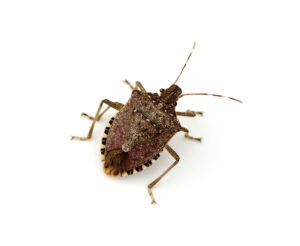Marmorated Stink Bug Invasion
What has a flat abdomen, is brown in color, and measures about 2 centimeters long and wide, oh and stinks if you touch it? If you answered the brown marmorated stink bug, you got it!
The brown marmorated stink bug originally thrived only in Asia but was accidentally introduced here in the United States in Allentown, Pennsylvania in 1998, most likely brought over in shipping containers. Now the invasive pest has been found in at least 42 states as well as the District of Columbia. Canada has also seen the pest, with the first documented sighting being in Ontario in 2010.

Other than the smell when you touch or squish it, you might wonder why this particular insect is considered a problem. The scientific name for the marmorated stink bug is Halyomorpha halys, and the main negative is the food preference of this variety of stink bugs. Farmers are concerned because they are known to feed on high-value crops and even ornamentals, in fact, their food preference has spread to over 170 species of plants! I guess they aren’t very picky eaters. From fruits to vegetables to field crops, the brown marmorated stink bug is a growing concern in the agricultural world. Here in Georgia, the concern has been for cotton and blueberries; although apples and tomatoes have been a common food source as well. In fact, this pest destroyed apple crops in the Mid-Atlantic region with $37 million in damage! And their numbers seem to be increasing pretty rapidly due, in part, to warming temperatures.
Now I have a few blueberry bushes and a few tomato plants in my backyard, and I certainly don’t want to share my small crop with this pest; however, I am not a farmer and have different concerns regarding this newer addition to Georgia’s pest life. I don’t want them invading my house in stinky, nasty droves! Is that a possibility? Well, yes.
Warm, fall days will find the brown marmorated hanging out on the exteriors of homes, they love a brick house by the way. They are absorbing heat but also have another game…finding a way into your home. The warmer temperatures inside your home plus light are just the kind of atmosphere these pests find inviting for their winter holiday. The good news is that you, nor your home is in any danger from the marmorated stink bug. They are not toxic, don’t bite, and don’t sting. But they are a nuisance to homeowners. Even though they don’t bite or sting, they do have a defense mechanism…aka their name, they stink. If they are disturbed or threatened, they release a nasty smelling chemical from their abdomens that aren’t usually that noticeable unless there is a group of them or you handle them directly.
The idea of bugs in the house is just kind of icky, especially in large numbers. So, let’s talk about how to prevent the problem before it happens to you. As with all pests, the best prevention is to seal any cracks or openings in your home, particularly around windows and doors. It is a wise homeowner who does frequent inspections of trouble spots, sealing out potential invaders. Next, check around your leaky faucets and any cracks in your plumbing. Moisture can lead to a lot of insect problems, so take care of leaks as quickly as possible. Remove excess moisture in problem areas with a dehumidifier. Store food in sealed containers and clean any crumbs from your floors and countertops. Lastly, be sure to clean and vacuum on a regular basis.
One important note is that while the brown marmorated stink bug is definitely classified as a pest, there are other varieties of stink bugs that are actually beneficial. They feed on harmful garden pests like the Mexican bean beetle, protecting our crops and food sources. It is helpful to know the difference in the species. The brown marmorated has striped antennae, their shoulders are smooth, and their mouth is small. The helpful stink bugs who protect our crops have a solid antenna, a spine-type appearance on the shoulders, and a stouter-looking mouth. If you’re like me, I don’t really plan to get close enough to see these distinctions, so calling a professional who knows the difference is much preferred.
At Canton Termite and Pest Control, our technicians are trained and experienced to distinguish between harmful versus beneficial. Still, you don’t want either variety in your home, so begin today to stink bug-proof your home by sealing out the winter visitors before they take up residence.
As always, if we can be of assistance, please reach out to us at Canton Termite at 770-479-1598.
Happy Fall from your hometown pest control company
BY: Robin
